Diamond Quality Factors
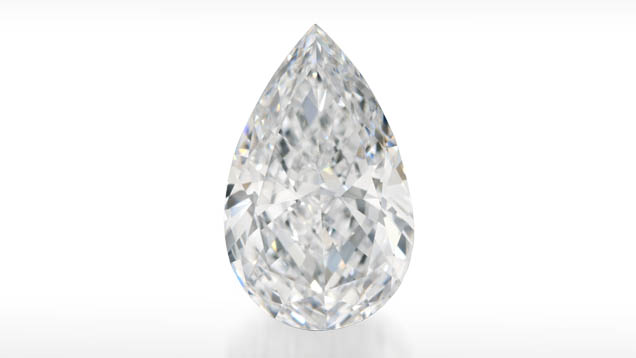
One of the first things most people learn about diamonds is that not all diamonds are created equal. In fact, every diamond is unique. Diamonds come in many sizes, shapes, colors, and with various internal characteristics.
All polished diamonds are valuable. That value is based on a combination of factors. Rarity is one of those factors. Diamonds with certain qualities are more rare—and more valuable—than diamonds that lack them.
Jewelry professionals use a systematic way to evaluate and discuss these factors. Otherwise, there would be no way to compare one diamond to another. And there would be no way to evaluate and discuss the qualities of an individual diamond. Diamond professionals use the grading system developed by GIA in the 1950s, which established the use of four important factors to describe and classify diamonds: Clarity, Color, Cut, and Carat Weight.
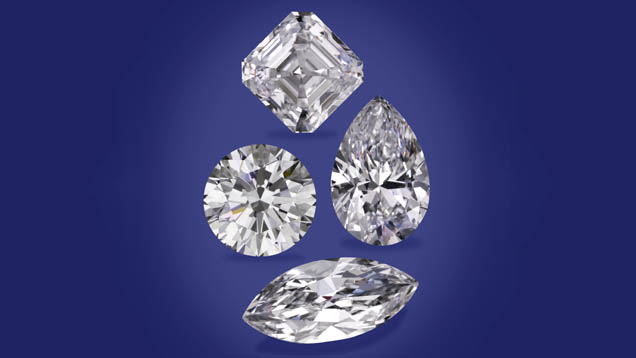
These are known as the 4Cs. When used together, they describe the quality of a finished diamond. The value of a finished diamond is based on this combination.
A diamond’s value is often affected by the rarity of one or more of the 4Cs. Colorless diamonds are scarce—most diamonds have tints of yellow or brown. So a colorless diamond rates higher on the color grading scale than a diamond that is light yellow. Value and rarity are related: In this case a colorless diamond is more rare and more valuable than one with a slight yellow color. The same relationship between rarity and value exists for clarity, cut, and carat weight.
The 4Cs describe the individual qualities of a diamond, and the value of an individual diamond is based on these qualities. The terms that people use to discuss the 4Cs have become part of an international language that jewelry professionals can use to describe and evaluate individual diamonds.
Today, the descriptions of each of the 4Cs are more precise than those applied to almost any other consumer product. And they have a long history. Three of them—color, clarity, and carat weight—were the basis for the first diamond grading system established in India over 2,000 years ago.
Color
Subtle differences in color can dramatically affect diamond value. Two diamonds of the same clarity, weight, and cut can differ in value based on color alone. Even the slightest hint of color can make a dramatic difference in value.
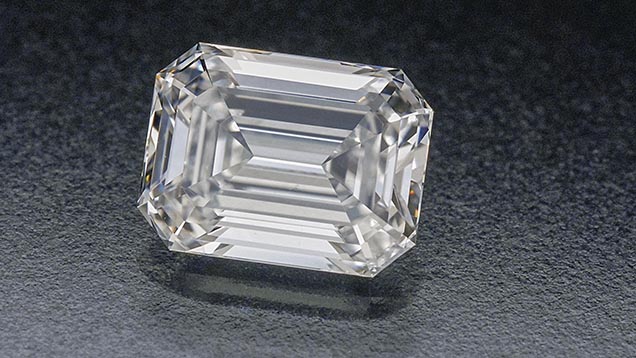
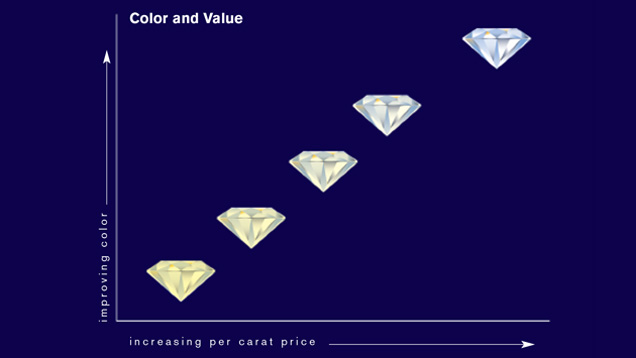
Diamonds come in many colors. Diamonds that range from colorless to light yellow and brown fall within the normal color range. Within that range, colorless diamonds are the most rare, so they’re the most valuable. They set the standard for grading and pricing other diamonds in the normal color range.
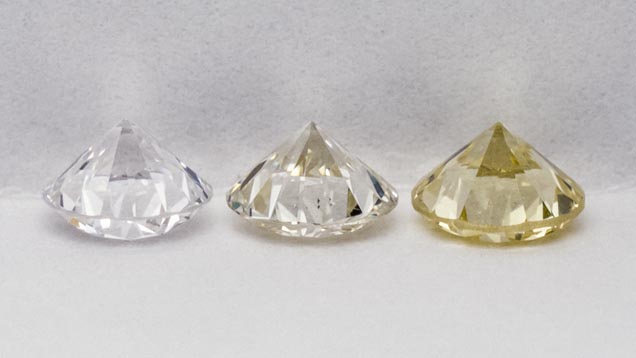
At the GIA Laboratory, diamonds are color graded under controlled conditions by comparing them to round brilliant diamonds of known color, called masterstones.


The GIA D-to-Z scale is the industry standard for color-grading diamonds. Each letter represents a range of color based on a diamond’s tone and saturation.
Many diamonds emit a visible light called fluorescence when they’re exposed to ultraviolet (UV) radiation. Although invisible to the human eye, UV radiation is everywhere. Sunlight contains it. Fluorescent lights emit it, too. Under the right conditions, you can see fluorescence in about 35 percent of gem diamonds.
Blue is the most common fluorescent color in gem-quality diamonds. In rare instances, fluorescence can be white, yellow, orange, or many other colors.
Strong blue fluorescence can make a light yellow diamond look closer to colorless in sunlight. Blue and yellow are color opposites and tend to cancel each other out, so blue fluorescence masks the yellow color. If the fluorescence is too strong it can make the stone look cloudy or “oily,” which can lower the value of the diamond.
Clarity
Few things in nature are absolutely perfect. This is as true of diamonds as anything else. Diamonds have internal features, called inclusions, and surface irregularities, called blemishes. Together, they’re called clarity characteristics. Clarity is the relative absence of inclusions and blemishes.
Among other things, blemishes include scratches and nicks on a diamond’s surface. Inclusions are generally on the inside, and some might break the surface of the stone. Sometimes, tiny diamond or other mineral crystals are trapped inside a diamond when it forms. Depending on where they’re located, they might remain after the stone has been cut and polished, and they can affect a diamond’s appearance.
Clarity characteristics might have a negative influence on a diamond’s value, but they can have positive effects as well. For one thing, they help gemologists separate diamond from imitations. (This is easier with included diamonds than with flawless ones.) And because no two diamonds have exactly the same inclusions, they can help identify individual stones. They can also provide scientists with valuable information about how diamonds form.
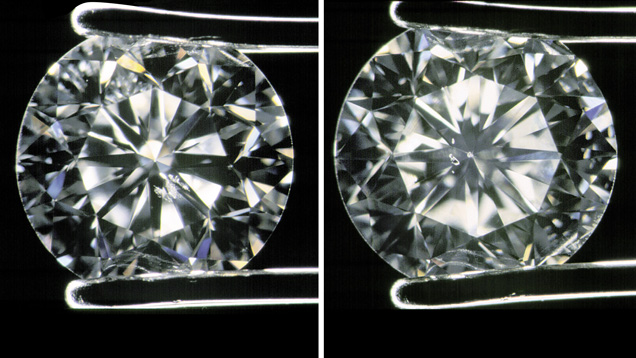
Like the rest of the 4Cs, clarity’s influence on value is directly related to the concept of rarity. Flawless is the top grade in the GIA Clarity Grading System. Diamonds graded Flawless don’t have visible inclusions or blemishes when examined under 10-power (10X) magnification by a skilled and experienced grader.
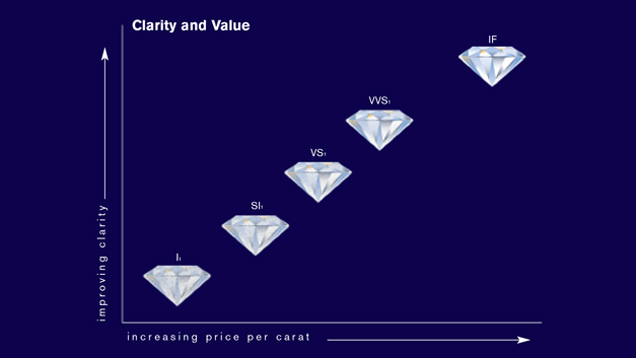
Flawless diamonds are very rare—so rare, in fact, that it’s possible to spend a lifetime in the jewelry industry without ever seeing one, and they command top prices.
At the other end of the scale are diamonds with inclusions that can be easily seen by the unaided eye. Between the two extremes are diamonds with inclusions visible only under 10X magnification. Stones in the middle range make up the bulk of the retail market.
There are 11 clarity grades in the GIA clarity grading system. They are Flawless, Internally Flawless, two categories of Very, Very Slightly Included, two categories of Slightly Included, and three categories of Included.
The effect of a clarity characteristic on the clarity grade is based on its size, number, position, nature, and color or relief.

Sometimes, one factor makes more difference to the clarity grade than the others. But it’s not always the same one. The relative importance of each factor varies from diamond to diamond. For example, an inclusion off to the side of a stone would have less impact on clarity than the same size inclusion located directly under the table. In this case, the position is probably the determining factor.
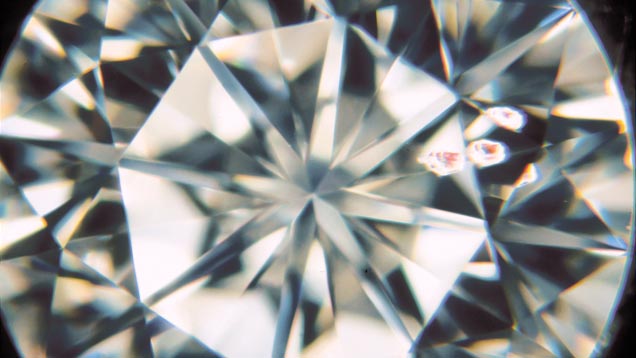
Occasionally, if an inclusion has the potential to cause damage to a stone, it can affect the grade. But this is rare, and usually applies only to Included (“I”) diamonds.
Diamond professionals use a set of terms that originally included very very slightly imperfect, very slightly imperfect, slightly imperfect, and imperfect. In recent years, the term imperfect has been replaced with included. (GIA uses included in its clarity grading system.)
These terms were shortened to the initials VVS, VS, SI, and I. The abbreviations eventually gained acceptance throughout the international diamond community. Their use is now widespread regardless of how the words they stand for translate into various languages. Very may translate to tres in French, for instance, but in France a very slightly included diamond is still a VS. Even a country like Russia, with a completely different alphabet, uses the same abbreviations.
Cut
A beautifully finished diamond is dazzling, with every facet displaying the craftsman’s skill and care. When a diamond interacts with light, every angle and every facet affects the amount of light returned to the eye. This is what gives it its face-up appearance.
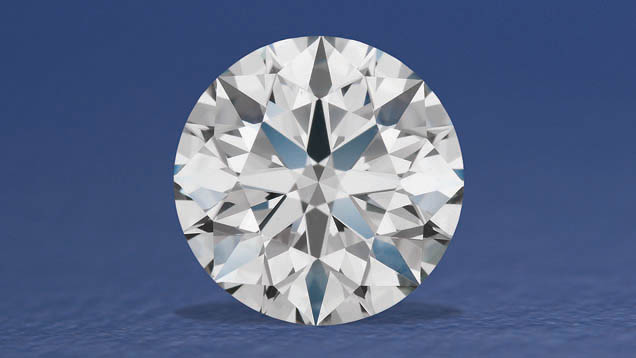
A diamond’s proportions determine how light performs when it enters the diamond. If light enters through the crown and goes out through the pavilion, the diamond will look dark and unattractive. Diamonds with different proportions and good polish make better use of the light, and will be bright, colorful, and scintillating.
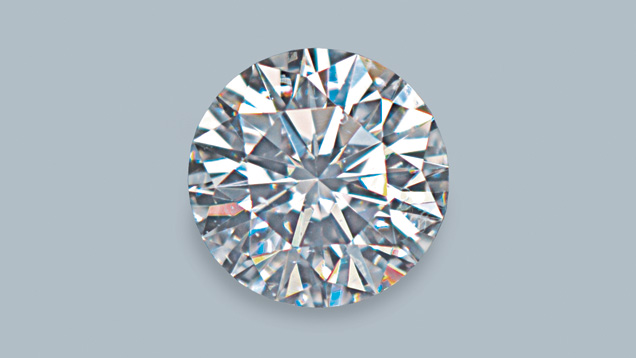
A well-cut diamond displays the beauty consumers expect to see in a diamond.
A beautiful diamond looks the way it does because of three optical effects: white light reflections called brightness, flashes of color called fire, and areas of light and dark called scintillation. Pattern is the relative size, arrangement, and contrast of bright and dark areas that result from a diamond’s internal and external reflections. There must be enough contrast between the bright and dark areas to give the pattern a crisp, sharp look.
The diamond industry has long known that some proportion combinations make light perform better than others. In recent years, however, scientists and researchers in GIA’s Research Department and the GIA Laboratory have shown that there are many variations and combinations of proportions that will maximize brilliance and fire in round brilliant cut diamonds.
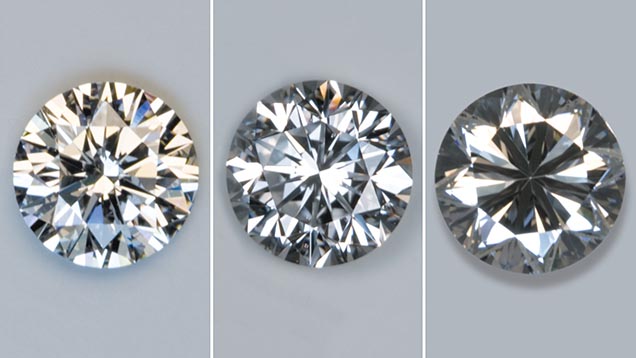
As a general rule, the higher the cut grade, the brighter the diamond. Under fluorescent lighting, these diamonds (left to right) display high, moderate, and low brightness.
The term “cut” also can describe a fashioned diamond’s shape. Shapes other than the standard round brilliant are called fancy cuts. They’re sometimes called fancy shapes or fancies. Fancy shapes also have names of their own, based on their shapes. The best known are the marquise, princess, pear, oval, heart, and emerald cut.
Carat Weight
Many goods are sold by weight—by the kilogram, ounce, pound, or ton. Even people who have never bought a diamond are used to the idea that weight and price are related. They understand that a larger diamond is probably more valuable than a smaller one. But there are two things that often surprise people when they start learning about diamonds and carat weight.
The first is the precision with which diamonds are weighed. Diamond weights are stated in metric carats, abbreviated “ct.” One metric carat is two-tenths (0.2) of a gram—just over seven thousandths (0.007) of an ounce. One ounce contains almost 142 carats. A small paper clip weighs about a carat.
The metric carat is divided into 100 points. A point is one hundredth of a carat.
Diamonds are weighed to a thousandth (0.001) of a carat and then rounded to the nearest hundredth, or point. Fractions of a carat can mean price differences of hundreds—even thousands—of dollars, depending on diamond quality.
Over a carat, diamond weights are usually expressed in carats and decimals. A 1.03-carat stone, for example, would be described as “one point oh three carats,” or “one oh three.” Weights for diamonds that weigh under a carat are usually stated in points. A diamond that weighs 0.83 carat is said to weigh “eighty-three points,” or called an “eighty-three pointer.”
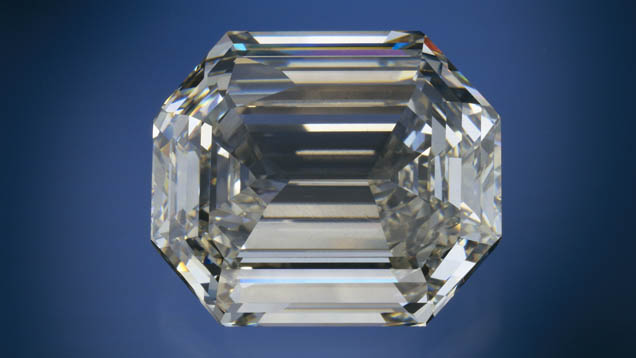
The relationship between rarity, weight, and value can be surprising. People know that a pound of sugar costs twice as much as a half-pound of sugar. But diamonds aren’t a commodity like sugar. Their price depends on a number of variables—weight is just one of them. So it’s not always easy to understand, or explain, why a 1-carat diamond is worth, say, $6,000, while a 2-carat diamond of similar quality might be worth $15,000.
It’s really a simple concept: Large diamonds are more rare than small diamonds. The more scarce something is, the more it is worth. So a larger stone doesn’t just cost more. It also costs more per carat. A 1-carat diamond weighs the same as four 0.25-carat diamonds. But even if all the other quality factors are equal, the larger diamond is worth much more than the sum of the four smaller diamonds.
Carat weight can also be symbolic. While the visual difference between a 0.98-carat diamond and a 1.01-carat diamond is negligible, many people will opt for the larger stone—even at a much higher price. Some weights are considered “magic sizes”: half carat, three-quarter carat, one carat, etc. There’s not much difference in their weights, but if both are D-color round brilliants with identical clarity and cut, the size makes all the difference. They really don’t look much different, but if a consumer’s heart is set on the one-carat size, the difference is enormous. The fact that the second stone is slightly over the “magic” one-carat size can give it as much as a 20 percent difference in price with only a 6-point difference in weight.
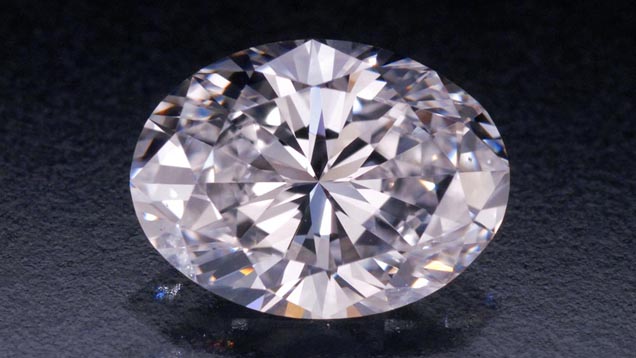
Don’t confuse the term carat with karat. Karat is a unit of measure used to describe how much pure gold there is in an alloy.



